Whether you’re a novice jogger or a competitive triathlete, bright reflections and harsh glares are a common frustration amongst almost all runners. Thankfully, this frustration is relatively easy to resolve. In most cases, putting on a good pair of running sunglasses will prevent glare and reflection from interrupting your run.
Unfortunately, many runners either don’t consider or deliberately eschew wearing running sunglasses. This could be due to the perception that running sunglasses are somehow uncool or unfashionable. Well, maybe that was true in the past, but in today’s market, running sunglasses are no less stylish than their casual competitors.
If you’re a runner who doesn’t wear running sunglasses, shame on you! But seriously, without adequate protection around the eyes, repeated exposure to glare will not only limit running visibility, but it will also increase your risk of suffering from a medley of eye conditions, including optical strain, cataracts, and tension headaches.
What’s more, while it’s common knowledge that ultraviolet (UV) radiation can damage our skin, many people don’t realize that UV rays can also cause serious damage to our sensitive eyes. If the eyes are left unprotected, long-term UV exposure will increase your chances of developing debilitating conditions like glaucoma and macular degeneration.
By incorporating a pair of running sunglasses into your everyday running attire, you’ll not only be making your run more enjoyable, but you’ll also be investing in the long-term health of your eyes.
Contents
- Features to Consider in Good Running Sunglasses
- Top 10 Best Running Glasses 2024
- 1. Best Overall Running Sunglasses: Under Armour Igniter Sports Sunglasses
- 2. Best Budget Running Sunglasses: goodr OG Sunglasses
- 3. Best Premium Running Sunglasses: Oakley Men’s Flak 2.0 Running Sunglasses
- 4. Best Wayfarer Running Sunglasses: Ray-Ban 2132 New Wayfarer Sunglasses
- 5. Best Women’s Running Sunglasses: Tifosi Women’s Alpe 2.0 Single Lens Sunglasses
- 6. Best Running Sunglasses for Small Faces: Tifosi Jet Running Sunglasses
- 7. Best Running Sunglasses for Wide Faces: Sojos Classic Square Polarized Sunglasses
- 8. Best Running Sunglasses for Trail Running: Duduma Polarized Sports Running Sunglasses
- 9. Best Round Frame Running Sunglasses: Sojos Classic Retro Round Running Sunglasses
- 10. Best Running Sunglasses with Interchangeable Lenses: Torege Polarized Sports Sunglasses with Interchangeable Lenses
- Guide to Buying the Best Running Sunglasses
- How Are Running Sunglasses Different to Regular Sunglasses?
- Benefits of Running Sunglasses
- Frame Style: Full or Half-Rim?
- Polarization: Should You Invest in Polarized Running Sunglasses?
- Frame Type: Finding Your Ideal Frame
- Manufacturing Quality: Buying Running Sunglasses That Last
- Breaking Down Sunglasses Terminology
- Best Running Sunglasses 2024: Top 5 Frequently Asked Questions
- Final Thoughts
Features to Consider in Good Running Sunglasses
Before we can take a look at the best running sunglasses for 2024, it’s important that we consider what features are relevant when shopping for a high-quality pair of running sunglasses. If you want a refresher on running sunglasses jargon, we’ve included a handy terminology guide further down this very page.
With so many unique types of sunglasses available, it can be difficult to know which style, lenses, and tints are right for you. To give you a better idea of how these attributes all fit together, we’ve put together a brief guide to what we believe are the four most important features in a pair of running sunglasses.
Material Quality
When shopping for running sunglasses, it may be tempting to simply buy the cheapest pair and hope that they’ll last a few years. However, not all sunglasses are created equal, with material quality in particular ranging from cheap, flimsy plastic to ultra-durable titanium steel. Both metal and plastic frames have their benefits and disadvantages, so your decision to purchase a plastic or metal frame will often come down to a combination of personal preference and running requirements.
Thanks to materials like zylonite and blended nylon, high-quality plastic frames are now approaching the strength and sturdiness of the average metal frame. However, because of their lighter weight, plastic frames tend to be slightly more comfortable on the face, making them a great option for long-distance running.
Nevertheless, metal frames remain the best option for runners who need a sturdy, long-lasting frame. This is especially true for impact-prone runners (i.e. trail runners or hill runners). Almost all metal frames are built with hypoallergenic metals, such as titanium or beryllium, making them safe for use by runners with metal allergies. Both of these metals, and many others, are flexible, durable, and resistant to corrosion.
If you’d like more details on the different materials used in sunglass frames, we’ve compiled a comprehensive breakdown of the most commonly used plastics and metals further down in this guide.
UV Protection
As we touched on earlier, one of the main reasons to wear running sunglasses is because they help to protect your eyes from harmful UV damage. A good pair of running sunglasses will have a layer of UV-protective coating embedded into each lens. UV protection can be further enhanced by adding additional coatings or a reflective tint to your sunglasses.
Ideally, your sunglasses will include both UVA and UVB protection — exposure to UVA rays will prematurely age eye tissue and increase the chances of developing cancerous growths, while exposure to UVB rays can lead to severe inflammation of the cornea.
Most sunglass companies use the term UV400 to denote lenses that are equipped with 99% to 100% UV protection. The term UV400 simply means that the lenses can block incident solar radiation with a wavelength of up to 400 nanometers, which is more than sufficient for blocking both UVA and UVB rays.
Polarized Lenses
Polarized lenses eliminate blinding glare and offer an added layer of protection against harmful UV rays. While polarized lenses are not 100% UV proof, they do provide better optical clarity. Depending on when and where you run, you may need a pair of running glasses fitted with both polarized lenses and UV400 protection.
You can find out more about the importance of investing in a pair of polarized running sunglasses further down in this guide.
Frame Size and Style
Choosing the correct frame for your face size and shape is another important aspect of shopping for running sunglasses. It’s important that your running sunglasses are fitted in order to prevent them slipping or moving around while you run. Conversely, you don’t want your frames to be too tight, particularly around the temples and ears. This can create pressure and tension, potentially leading to visual discomfort and/or headaches.
Beyond frame size, aesthetic considerations, especially things like frame style, will also factor into your purchase decision. The three most common running sunglass frame styles are wrap-arounds, rounds, and wayfarers.
Another potential consideration is the pros and cons of half-rim frames compared to full-rim frames. Half-rim frames have a sportier aesthetic, something that’s often more appealing to competitive runners. Half-rim sunglasses will also improve breathability, allowing more air to circulate around the eyes and face during a run.
On the other hand, the sturdier construction of full-rim frames means they’ll be able to withstand greater wear and tear than equivalent half-rim running sunglasses. Additionally, a full-rim style is more accommodating for runners who need to fit thick prescription lenses into their running sunglasses.
Now that you know exactly what you need to find the perfect pair, let’s take a look at the best options on the market today.
Top 10 Best Running Glasses 2024
1. Best Overall Running Sunglasses: Under Armour Igniter Sports Sunglasses
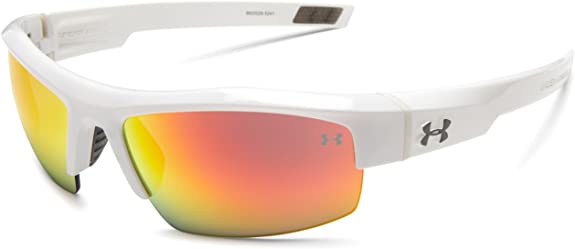
Editor’s Rating:
Quick Facts
- Materials: Polycarbonate ArmourSight lens and titanium/polyamide frame
- Frame style: Half-rim
- Tint: Grey/Orange
- Hardcase: No
Under Armour’s Igniter sports sunglasses are the best overall pair of running sunglasses currently on the market. Starting with material quality, Under Armour Igniters are built from a shatter-resistant combination of titanium and polyamide. Augmenting these premium-grade materials is a pair of scratch-resistant, shatterproof, polarized polycarbonate lenses. Treated with UV400 coating, these lenses do everything right when it comes to reducing glare and defending against harmful UVA and UVB rays.
However, the real drawcard of the Igniter sunglasses is ArmourSight, Under Armour’s patented lens design. In addition to being 10 times stronger than traditional polycarbonate lenses, ArmourSight lenses are designed to give runners 20% more undistorted peripheral vision.
To round out this impressive ensemble, Igniters are equipped with a suite of stabilizing features, including three-point co-molded nose pads and sweat-resistant frame arms. These features will not only stop your glasses from falling off mid-run, but they’ll also prevent the frame from bouncing up and down on your nose and brow.
The only real downside to these running sunglasses is the fact that they come with a soft case instead of a hardcase. If you want to extend the lifespan of your eyewear, we recommend purchasing either a dedicated Under Armour hardcase or a third-party hardcase for sunglasses.
- ArmourSight lens technology
- UV400 protection
- Stable frame design
- No hardcase included
2. Best Budget Running Sunglasses: goodr OG Sunglasses
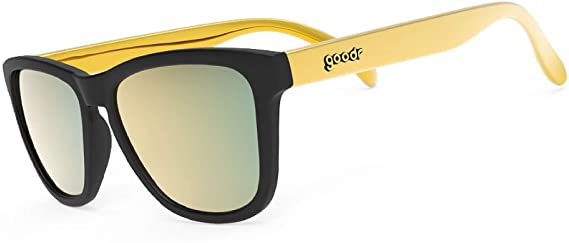
Editor’s Rating:
Quick Facts
- Materials: Polycarbonate lenses and plastic frame
- Frame style: Full-rim
- Tint: Gold
- Hardcase: No
The running sunglasses that make up goodr’s OG range are designed to look and feel like regular sunglasses. This makes them an ideal option for runners who want to avoid an overly sporty aesthetic. Sitting on the squarer side of wayfarer style frames, the fit of these glasses is best suited to runners with oblong or rounded faces.
Despite their low price point, goodr OG sunglasses still feature UV400 protection and lens polarization. The value of these sunglasses is further amplified when you consider the number of specialized materials packed into the lenses. These materials include a scratch-resistant and shatterproof veneer, a polarized filter, and an anti-saltwater coating.
Unfortunately, goodr OG sunglasses are not fitted with rubberized nose pads or rubberized arm bits that keep them in place on any terrain like the Oakley Flak. Nevertheless, with a no slip and no bounce guarantee from goodr, these sunglasses should stay firmly in place during everyday runs. Finally, please note that this particular model doesn’t include a protective hardcase, so you’ll need to purchase one separately.
- UV400 protection
- Polarized lenses
- No slip, no bounce guarantee
- No nose or arm pads
- No hardcase included
3. Best Premium Running Sunglasses: Oakley Men’s Flak 2.0 Running Sunglasses
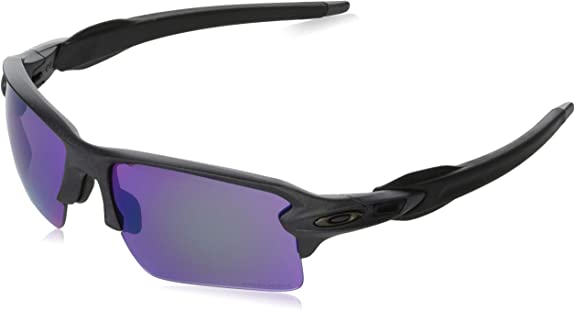
Editor’s Rating:
Quick Facts
- Materials: Polycarbonate lenses and plastic frame
- Frame style: Half-rim
- Tint: Available in multiple tints
- Hardcase: Yes
Oakley has an impressive reputation in the eyewear market, and the Oakley Flak 2.0 certainly lives up to the name. Available in a variety of tints, you can customize Oakley Flaks to suit any kind of running environment. Many of these tints also use Oakley’s very own PRIZM polarization technology for ultra-bright running conditions. This specialized technology creates optimal clarity when used in medium to bright light conditions. At 12% light emission, your environment will appear naturally vibrant and richly detailed.
Perhaps the standout feature of these sunglasses is the use of Unobtanium rubber, Oakley’s trademarked nose and arm piece material. In addition to providing a superb level of grip, the Unobtanium pieces help widen the sunglasses for a more comfortable fit.
However, if you need running sunglasses with a wider fit, don’t worry: you have plenty of options. Personally, we think Sojos’s Classic Square Running Sunglasses are one of the best wide-fit options on the market.
While this model is slightly more expensive than the other running sunglasses on this list, you really are paying for quality and flexibility. You can even swap out lenses to suit the weather and light conditions of the day. While these sunglasses are advertised as fog-resistant, the absence of ventilation slits in the frame may reduce effectiveness in humid weather conditions.
- Polarized lenses
- Multiple tints available
- Fitted nose and arm pads
- Some lens variants are non-polarized
- No ventilation slits
4. Best Wayfarer Running Sunglasses: Ray-Ban 2132 New Wayfarer Sunglasses

Editor’s Rating:
Quick Facts
- Materials: Glass lenses and nylon frame
- Frame style: Full-rim
- Tint: Available in multiple tints
- Hardcase: Yes
Ray-Ban has always been a leader in the eyewear industry, consistently finding new and innovative ways to reinvent the classic wayfarer. This latest remodel features an overall slimmer and more refined frame, with the lens shape veering towards a slightly sportier look.
With lenses made from glass, Ray-Ban 2132s are heavier than traditional running sunglasses. That being said, these glasses are still reasonably lightweight, sitting at about 1.4 ounces. By taking this risk, Ray-Ban has been able to pack an enormous number of features into their high optical clarity lenses, including a UV400 coating, a polarized filament, and chemically strengthened scratch resistance.
These sunglasses are a perfect transitional piece of eyewear, being both practical and sleek enough to be worn casually as well as during a run. The only real downside to these sunglasses is the lack of a rubberized nose piece. However, given the slimmer frame size of these wayfarers, you shouldn’t experience any slipping or bouncing while running.
The wayfarer shape is best suited to rounder face shapes. If you have a angular face and want a snugger pair of running sunglasses, check out the Sojo Classic Retro Round Running Sunglasses for a more flattering fit.
- UV400 protection
- Polarized lenses
- Classic wayfarer style
- No specialized nose pads
5. Best Women’s Running Sunglasses: Tifosi Women’s Alpe 2.0 Single Lens Sunglasses

Editor’s Rating:
Quick Facts
- Materials: Polycarbonate lenses and nylon frame
- Frame style: Full-rim
- Tint: Brown
- Hardcase: Yes
The perfect blend of practicality and style, Tifosi Alpe women’s running sunglasses have it all. Shatterproof polycarbonate lenses are framed with an oval full-rim, offering maximum support for both the lenses and the arms. If you enjoy getting ready for a run, you’ll be happy to hear that Tifosi’s sunglasses are available in a wide range of frame patterns, ensuring that you’ll always be able to customize your shades to match your running gear.
Made from nylon, these sunglasses have a very high compressive strength ratio compared to standard plastic frames. However, like the Oakley Flak, the most unique aspect of these sunglasses is actually the trademarked nose pad design. Made from hydrophilic rubber, these nose pads become grippier the more you sweat, keeping your glasses ultra-stable in both humid and rainy weather. Unfortunately, while these glasses have UV400 protection, they are single lens and are not polarized like most variants of the Oakley.
Measuring at only 3 inches high and 4 inches wide, Tifosi Alpe sunglasses tend to fit best for women with petite facial features. Alternatively, if you’d prefer a less feminine pair of small face sunglasses, take a look at the Tifosi Jet Running Sunglasses.
- UV400 protection
- Available in multiple colors
- Hydrophilic nose pad
- Non-polarized lenses
6. Best Running Sunglasses for Small Faces: Tifosi Jet Running Sunglasses
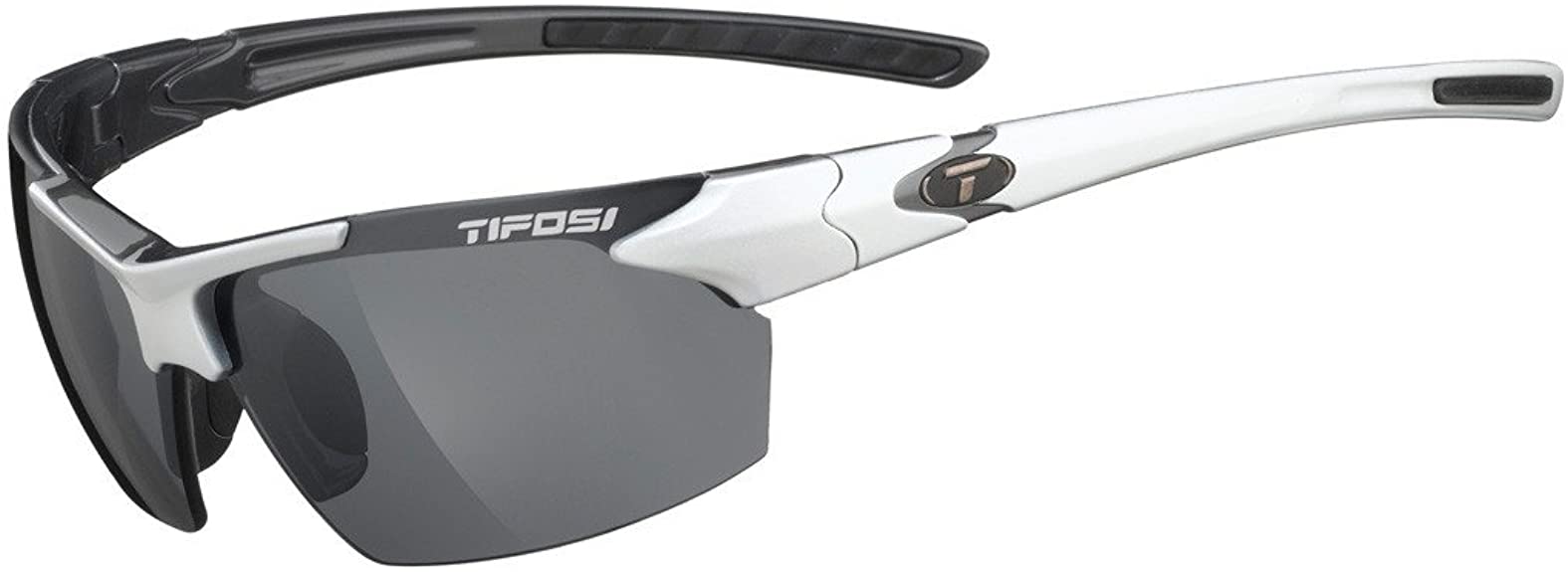
Editor’s Rating:
Quick Facts
- Materials: Polycarbonate lenses and nylon frame
- Frame style: Half-rim
- Tint: Available in 3 tints
- Hardcase: Yes
With three different tints available, you can customize these sporty half-rims to suit your unique style and routine running conditions. The lens dimensions (2.5 inches wide and 1.6 inches high) and their slightly off-center position makes these glasses an excellent choice for runners with smaller heads or more petite facial features.
Featuring hydrophilic nose and ear pads, these glasses are guaranteed to stay put during your run. Polycarbonate lenses are both scratch and shatterproof, creating a sturdy pair of sunglasses that can handle wear and tear. In a stroke of foresight, Tifosi has also applied a trademarked coating to their nylon frame in order to increase its durability against the chemicals found in sunscreen.
Though these glasses offer UV400 protection, the lenses themselves are not polarized. For this reason, Tifosi Jet running sunglasses may not be suitable for ultra-bright or high-glare running environments.
Looking for a slimmer pair of women’s running sunglasses from Tifosi? Check out the Tifosi Women’s Alpe 2.0 Running Sunglasses.
- UV400 protection
- Hydrophilic nose and ear pads
- Protected against sunscreen degradation
- Non-polarized lenses
7. Best Running Sunglasses for Wide Faces: Sojos Classic Square Polarized Sunglasses
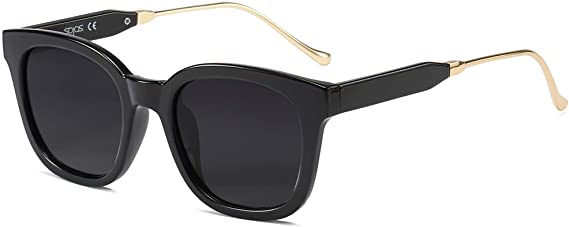
Editor’s Rating:
Quick Facts
- Materials: Composite polycarbonate lenses and plastic frame
- Frame style: Full-rim
- Tint: Multiple tints available
- Hardcase: Yes
Featuring classy gold metal arms and prominent solid metal hinges, these glasses can accompany you from a morning run to an afternoon at the beach with ease. With a 5.7-inch frame, Sojos’ classic square running sunglasses are perfect for runners who find regular fit sunglasses too restricting. The 2-inch composite lenses are similarly substantive, featuring a polarized laminate, UV400 protection, and a reflective mirror coating.
Likely made from zylonite, Sojos’ plastic frame has considerable flexibility, making it adaptive to the size of wide faces whilst maintaining shape and strength. While these frames do include a thin nose piece, there is no sign of any rubberized nose grips on the arms or rims, so there’s a chance that runners with a thinner nose may experience some slippage.
If you need sunglasses for a wider face but prefer a half-rim frame, Oakley Flak running sunglasses are a great option.
- UV400 protection
- Polarized lenses
- Premium metal-plastic frame
- No specialized nose pads
8. Best Running Sunglasses for Trail Running: Duduma Polarized Sports Running Sunglasses
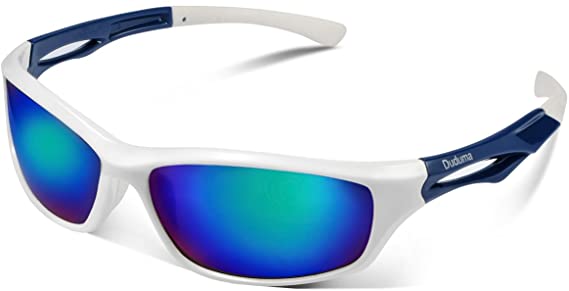
Editor’s Rating:
Quick Facts
- Materials: Polycarbonate lenses and plastic frame
- Frame style: Full-rim
- Tint: Multiple tints available
- Hardcase: No
These wrap-around sunglasses, available in a massive range of colors and tints, are the perfect trail running companion. Equipped with UV400 protection, Duduma’s sturdy polarized lenses have been engineered to automatically adjust user visuals based on surrounding light levels. That means no more having to take your sunglasses off on the shadier parts of your trail run.
Manufactured from reinforced plastic, Duduma frames are exceptionally lightweight and durable, with sturdy polycarbonate lenses protecting your eyes from the external elements. To counteract the bumpiness of trail runs, Duduma running sunglasses are fitted with grippy nose pads. Snug yet comfortable, these nose pads will ensure that your glasses won’t be bouncing around as you traverse rough trails. Finally, air vents on the arms of these glasses allow for generous air circulation around the cheeks and brow, minimizing fog buildup from rain or labored breathing.
The one downfall to these glasses is their size. With a frame length of 5.1 inches, the wrap-around style and snug fit nose pads can be mildly uncomfortable for runners with wider faces. For a more relaxed fit, check out the Sojos Classic Square Polarized-Sunglasses.
- UV400 protection
- Light-adaptive
- Polarized lenses
- Anti-fog vents
- Not suitable for wider faces
9. Best Round Frame Running Sunglasses: Sojos Classic Retro Round Running Sunglasses
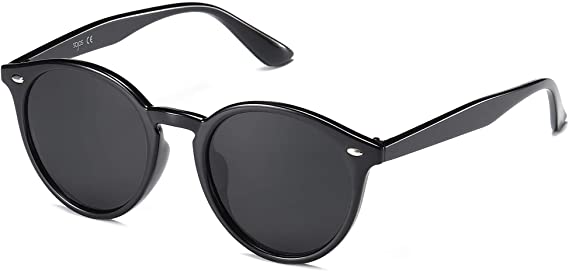
Editor’s Rating:
Quick Facts
- Materials: Composite polycarbonate lenses and plastic frame
- Frame style: Full-rim
- Tint: Multiple tints available
- Hardcase: No
If you’re looking for a pair of retro sunglasses that can be worn on every occasion, look no further than Sojos’ classic round sunglasses. Boasting a chic round frame design, these sunglasses are available with 13 unique frame styles.
The frame itself, a 5.6-inch model composed of lightweight zylonite, will keep these sunglasses snug on your face even in the hottest and sweatiest of conditions. While Sojos Retro sunglasses do not come with a rubberized nose piece, the smaller nose pads still manage to support a comfortable and stable running experience.
With 2-inch full-rims, the Sojos round frames aren’t too overwhelming on the face and look great on individuals with sharp and/or narrow features. Meanwhile, the composite polycarbonate lenses offer exceptional coverage, even in high-glare conditions. Paired with polarization and UV400, Sojos’ round running sunglasses are another excellent choice for runners who prefer to exercise in bright, sunny conditions.
Need glasses for a rounder face shape? Check out Ray-Ban’s 2132 New Wayfarer Sunglasses.
- UV400 protection
- Polarized lenses
- Retro shape
- Multiple frame styles available
- No rubberized nose pads
10. Best Running Sunglasses with Interchangeable Lenses: Torege Polarized Sports Sunglasses with Interchangeable Lenses
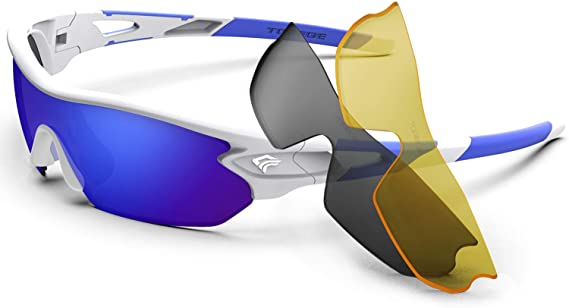
Editor’s Rating:
Quick Facts
- Materials: Polycarbonate lenses and plastic frame
- Frame style: Half-rim
- Tint: Blue lens, black polarized lens, and yellow lens
- Hardcase: Yes
These wrap-around running sunglasses come with three interchangeable UV400 lenses, with each lens being optimized for a specific type of light condition. In spite of this added versatility, Torege sports sunglasses have remained surprisingly affordable.
The primary lens uses a blue tint to reduce everyday glare, enhance color perception, and improve contrast. Also included is a polarized black lens for facing down ultra-bright or sunrise/sunset running conditions.
The last lens, a yellow lens, is included for nighttime use. With a light transmission ratio of 86%, yellow-shaded lenses will significantly enhance contrast in low-light night conditions. Finally, Torege’s very own TORIEX lens technology amps up contrast and color, boosting optical clarity and contour definition, no matter the time of day.
If you don’t need interchangeable lenses but still want a classic sporty look, check out the Under Armour Igniter Sports Sunglasses.
- Affordable
- Versatile assortment of interchangeable lenses
- TORIEX lens technology
- Not all lens options are polarized
Guide to Buying the Best Running Sunglasses

Now we’ve looked at a lot of different sunglasses. With so many features and styles to choose from, it can be a tricky task to make a final purchase decision. To help you pick the perfect pair of shades, we’ve put together a handy guide to running sunglasses. This guide includes everything you need to know before buying a pair of running sunglasses, from defining common technology to breaking down the pros and cons of various frame and lens materials.
How Are Running Sunglasses Different to Regular Sunglasses?
As the name suggests, running sunglasses are much like regular sunglasses but are designed to be used while running or exercising. They differ from regular sunglasses in that they are usually more fitted, have a smaller, sleeker frame, and will generally have a lens specifically designed to minimize glare and protect the eyes from sun damage.
Benefits of Running Sunglasses
The benefits of using running sunglasses are substantial. Not only will they keep you looking stylish, but they are also a practical tool that can improve your overall running performance.
- Minimize Glare: One of the primary design functions of running sunglasses is minimizing harsh glare and reducing the sunlight impact on your eyes and face. Minimizing glare will also minimize squinting, preventing running wrinkles and reducing the occurrence of tension headaches.
- UV Protection: The most significant benefit of wearing running sunglasses is the added UV protection. Shielding your eyes from damaging UV rays is crucial to maintaining your long-term eye health.
- Weather Protection: Keeping your eyes clear and free from debris whilst running is important for the safety of yourself and others. A good pair of running sunglasses will not only protect your eyes from bright lights and glare, but they’ll also act as a protective barrier against wind, rain, and snow.
- Bug Protection: Another added benefit of running sunglasses is that they will protect your eyes against flying bugs!
Frame Style: Full or Half-Rim?
With pros and cons for both options, whether you opt for a full or half-rim is largely down to personal preference. Full-rims are much sturdier compared to half-rim frames and will usually provide superior lens protection should you routinely drop your sunglasses. Furthermore, if you require large prescription lenses, a half-rim frame may not be able to support the extra weight and size.
Nevertheless, half-rim running frames tend to be more popular due to their sporty aesthetic and lightweight body. In fact, the top entry on our list ended up being a pair of half-rim sunglasses. Half-rim glasses also provide more breathability around the eyes and face, making them less likely to fog up in rainy weather or from labored breathing.
Polarization: Should You Invest in Polarized Running Sunglasses?
Serious runners should definitely invest in running sunglasses with polarized lenses. Compared to non-polarized sunglasses, polarized lenses not only provide an added layer of protection against harmful UV rays, they also dramatically reduce glare when you’re running in bright environments.
If you’ve never heard the term, polarization is an added thin layer in the lens of your sunglasses. When vertical light hits a surface, light bounces off to create bright glare. Polarization works by acting as a reflective surface for bright light and glare, sending horizontal light waves away from your eyes while still allowing regular vertical light to filter through. Thanks to their glare-reducing properties, polarized lenses will also boost optical contrast, thereby improving your overall visibility when running in low-light conditions.
If you’re as convinced as we are on the benefits of polarization, we can recommend the goodr OG Sunglasses as a high-quality yet affordable option.
Frame Type: Finding Your Ideal Frame
The last thing you want to be worrying about when you’re running is having your sunglasses sliding down your nose or bouncing around on your face. Finding a style of frame that not only suits your facial features, but also fits your head is the key to keeping your sunglasses affixed to your face during a fast-paced jog or bumpy trail run.
Curved Wrap/Wrap-Around
A wrap-around frame refers to glasses with a rim that is long enough and narrow enough that it can wrap around your face. This style of frame is great for running and sports in general as the narrow design typically leads to a snugger fit — this is particularly useful if you have a smaller head.
If you’re interested in purchasing a wrap-around style of glasses, it’s hard to look past the Torege Polarized Sports Sunglasses.
Round
Round frames are a great option for runners who want to tone down the sporty look in favor of a more sophisticated and chic aesthetic. Featuring round rims and lenses, round frames tend to remain more centered on the face compared to wrap-around or wayfarer styles, making them perfect for squarer-faced runners looking to accentuate their sharp features.
If you have more angular features, the Sojo Classic Retro Round Running Sunglasses has a good chance of being a perfect fit.
Unfortunately, even though round frames look great, the looser design can make them less practical for running if they haven’t been fitted. To avoid the dreaded mid-run sunglasses bounce, look for fitted round running sunglasses with stabilizing nose grips.
Wayfarer
The broad trapezoidal shape of the wayfarer frame makes it an excellent option for running sunglasses as it provides more glare coverage for your eyes and face. However, given the larger frame style, wayfarers can appear oversized on smaller faces.
Better suited to oblong, oval, or round faces, wayfarer running sunglasses offer a classic look which closely emulates the style and shape of regular sunglasses. Much like round sunglasses, wayfarers are not as fitted as wrap-around style frames.
So, if you have a round or oval-shaped face, it’s definitely worth considering the Ray-Ban 2132 New Wayfarer Sunglasses.
Manufacturing Quality: Buying Running Sunglasses That Last
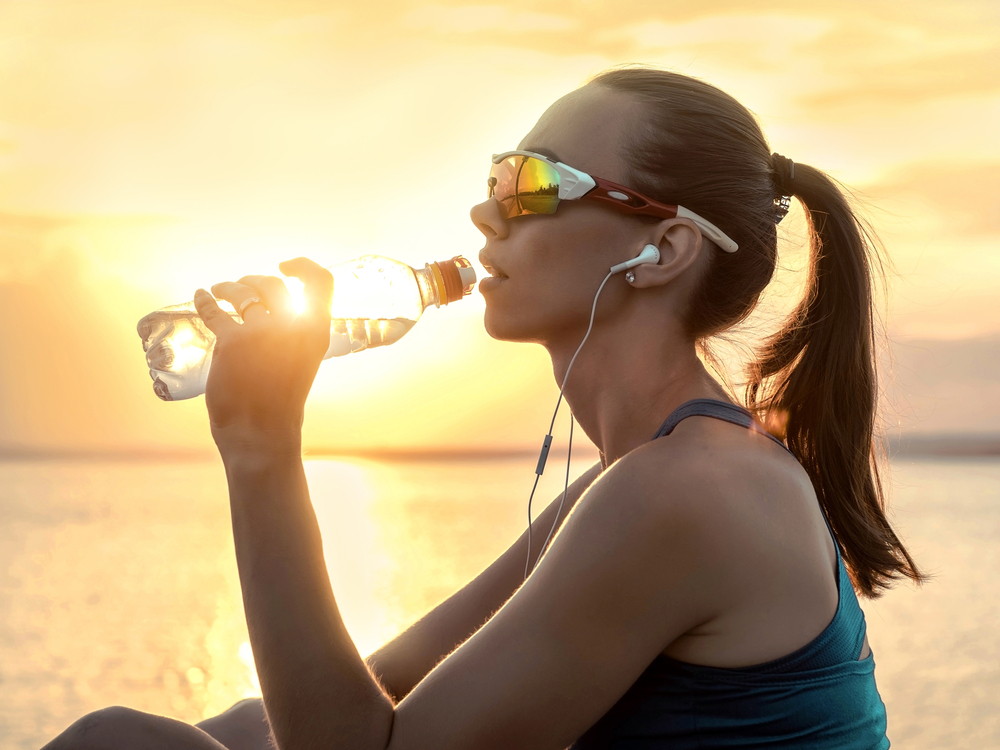
Purchasing running sunglasses should never be an arduous process, but it is important that you take the time to find a pair of glasses that are manufactured with materials that suit your running lifestyle. Read on to discover more about which lens and frame materials may be right for you.
Lens Material
With so many lens types available, finding the right one can be tricky. When it comes to lens materials, the main considerations for runners are weight, optical performance, and durability. There are three main running sunglass lens materials, each of which can be customized with tints, coatings, or prescriptions.
- Glass: Versatile and resistant to scratches, traditional glass lenses are usually rated as the best type of lens for optical clarity. If you’re looking for lenses with low levels of distortion, check out Ray-Ban 2132 New Wayfarer Sunglasses.
- Polycarbonate: Perhaps the most popular lens types for running sunglasses, polycarbonate is impact-resistant, lightweight, and very affordable.
- Polyurethane: Lenses made from polyurethane are lightweight and flexible. Often regarded as an alternative to glass, polyurethane lenses make up for their slightly lower optical clarity by being more resistant to impacts.
Frame Material
The frames in running sunglasses are made from either plastic or metal. To give you a better idea of their respective strengths and weaknesses, we’ve compiled a brief breakdown of both plastic and metal frame designs.
For starters, plastic frames are generally a more popular choice as they’re very affordable and extremely lightweight. However, plastic frames are often less durable than metal frames, with low-quality plastic tending to lose strength and shape when subjected to impact-prone, outdoor running.
To give you a better idea of your plastic frame options, we’ve listed the three most common plastic materials used in running sunglasses:
- Blended nylon: With a variety of different casting options, blended nylon is engineered for long-term wear resistance and high compressive strength. Sunglasses like the Tifosi Jet Running Sunglasses are manufactured using a blended nylon variant.
- Zylonite: Pliable and inexpensive, zylonite is valued for its lighter weight and wide range of multicolored material variants.
- Optyl: Made from epoxy resin and patented by Carrera, the main benefit of Optyl is its pliability, a feature that makes it a good choice for runners who want a frame that will mold to the shape of their head.
If you’re in the process of perusing different sunglasses, keep in mind that many manufacturers will refer to their frames as ‘plastic’ without listing any specific plastic varieties.
Metal Frames
Metal frames generally make the most durable sunglasses, making them the preferred option for runners who value the longevity of their eyewear. The most common metal frame varieties include:
- Titanium: Anti-corrosive and hypoallergenic, titanium makes strong and lightweight sunglass frames. If you need an extra strong titanium frame, look no further than the Under Armour’s Igniter Sports Sunglasses.
- Aluminum: Often used in high-end frames, aluminum is strong, flexible, and highly resistant to corrosion.
- Monel: Made from a mixture of nickel alloys and boasting similar anti-corrosion properties to titanium, monel is known for its high mechanical strength and attractive gray-green appearance.
- Stainless steel: Stainless steel frames are an inexpensive and slightly heavier alternative to titanium frames.
- Beryllium: A cheaper alternative to titanium and aluminum, beryllium has most of the benefits of titanium but is available in a larger range of colors.
- Flexon: An alloy of titanium, flexon is an extremely malleable material. This means frames made from flexon can retain their shape even after being bent or twisted. As such, flexon frames are a fantastic option for younger runners.
Breaking Down Sunglasses Terminology
There is an overwhelming amount of information about sunglasses out there and understanding technical terms such as base tint and coating can be confusing. To make finding your ideal pair of sunglasses easier, the following list will break down some of the most commonly used running sunglasses terminology:
- Temples: The temples refer to the arms of the sunglasses. These extend from the frame and usually rest on or behind your ear.
- Rim: The sunglasses rim holds the lenses in place and crosses over the nose. There are three different rim styles: full-rim, half-rim, or rimless.
- Earpiece: The earpiece covers the end of the temples, providing additional comfort and protecting the metal or plastic from scratching or irritating your ear and head
- Hinge: The hinge connects the frame to the temples and allows the frame to be neatly folded when not in use. There are a number of different hinge styles. However, barrel hinges are by far the most common type used for running sunglasses.
- Lens: The lens is the glass or plastic that you look through that sits in the rim of the glasses.
- Coating: Different coatings can be applied to sunglass lenses in order to make utility or aesthetic changes Three of the most common coatings for running sunglasses are hydrophobic coatings (creates a waterproof lens that repels water and sweat), mirrored coatings (acts as a reflective barrier for light and glare), and scratch-resistant coatings (helps prevent scratches).
- Polarized: A polarized lens is a lens that uses a special chemical laminate to filter out horizontal light waves, reducing glare and improving UV protection.
- Tints: Different tints are applied to sunglass lenses in order to enhance clarity, reduce glare, and improve visibility in variable lighting conditions.
- Base Tint: The base tint is the color embedded into sunglass lenses. The base tint creates the color you see when you look out of glasses.
- UV Filter: A UV filter is a coating that is applied to lenses in order to protect the eyes from UV rays.
Best Running Sunglasses 2024: Top 5 Frequently Asked Questions
1. Is it weird to run with sunglasses?
No! Running with sunglasses isn’t weird. In fact, running with sunglasses will likely improve your running performance due to the reduction in glare and improvement in contrast. Furthermore, wearing running sunglasses will also reduce strain and squinting, two of the most common causes of mid-run headaches.
2. Are polarized sunglasses good for running?
As we’ve mentioned earlier, polarized lenses filter out harsh sunlight, reducing the intensity of light incident on your eyes while running. Consequently, polarized sunglasses are a great choice as a pair of running sunglasses, particularly if you run in high-glare environments (i.e. an exposed running track).
3. Should you wear running sunglasses on a cloudy day?
Even on cloudy or overcast days, it’s important to wear running sunglasses. No matter the weather, UV rays will still reach the Earth’s surface, causing damage to unprotected skin and eyes. Wearing UV running sunglasses will protect your eyes from both glare and UV damage. What’s more, running glasses with brown, rose, amber, or orange-tinted lenses can actually improve your vision on overcast days as they improve contrast in the absence of shadows.
4. What color lens is the best for bright days?
Grey or brown lens running sunglasses are a safe bet for bright, sunny days as they provide the best protection against high-intensity light.
5. Should you wear UV sunglasses when running?
Yes! If you’re heading outside for any meaningful length of time, you should always wear UV sunglasses. This is the easiest and most effective way to protect your eyes from UV damage and reduce your risk factor for conditions like glaucoma and macular degeneration. You can also consider a running hat to keep you protected from the sun.
Final Thoughts
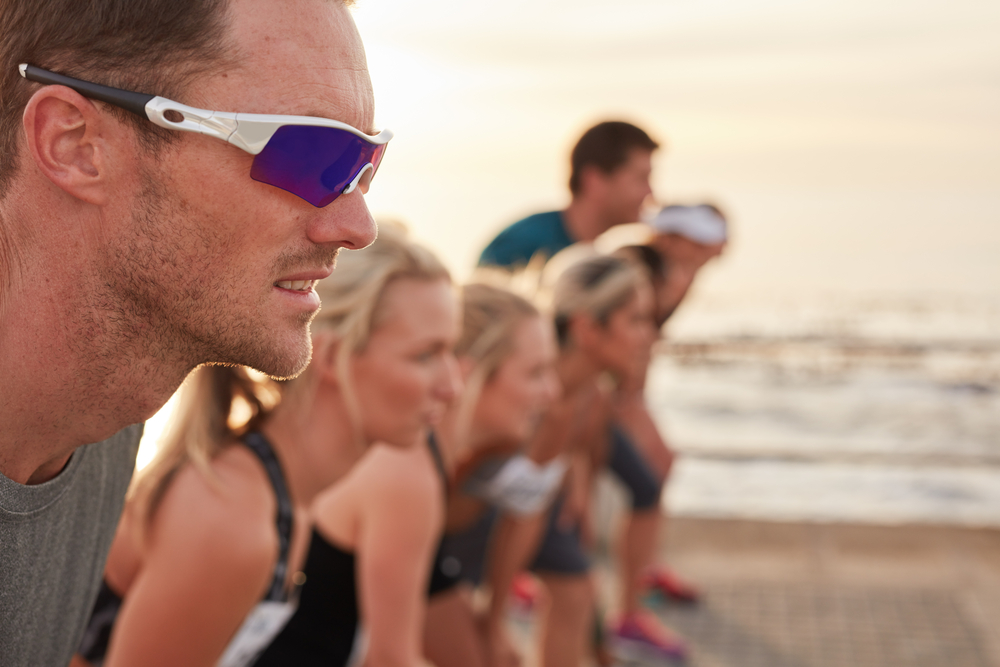
Whether you run for leisure or competition, running with bright light and glare in your eyes can be the difference between extreme discomfort and reaching your running goals. If you’re concerned about the health of your eyes or how glare may be impacting your running performance, the biggest change you can make is investing in a top-quality pair of running sunglasses.
While you’re gearing up, be sure to take a look at our guide to the best running headbands, too—they’ll keep your hair in place, sweat out of your eyes, and your mind focused on running, making them an essential for all seasons.
